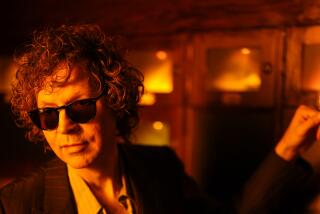Suddenly, the ‘Old’ Sound Once Again Is New : Trends: Prices are up on those old recordings, albums have been re-released on CD and disco clubs are making a comeback. Clearly, it’s nostalgia time.
- Share via
Disco music crept into a certain kind of intellectual respectability only recently. It was a trend too evil to die, like the tons of rotting polyester shirts that will inevitably make their way onto all the hippest torsos.
Suddenly, in used-record stores all over the country, old Rose Royce LPs are moved from the 23-cent bins to the $3-and-up sections. KC & the Sunshine Band makes a triumphal New York appearance. A disco in Manchester, England, becomes the most famous club in the world.
And there’s the inevitable nostalgia for the good days--especially the glamorous Andy-Bianca-Halston Studio 54 thing so intricately recounted in the Warhol tell-alls. It was America’s last, pre-AIDS fling with drugs, fashion and promiscuous sex. The music’s getting re-released on CD now, too, notably Rhino Records’ two-volume salute, “The Disco Years.”
Was disco as bad as we thought?
The revisionist theory of disco can be divided into several parts:
* Disco was a music dominated by blacks and gays. Therefore, the late-’70s anti-disco thing was really just a front for racism and homophobia.
* Disco was the first mainstream pop movement to put women, who sang lead on almost every record, in charge of their own sexuality. Guys who didn’t like disco were really just threatened by that.
* In the wake of punk’s implosion, the most advanced pop music comes from those artists--Prince, the Pet Shop Boys, Madonna, Stone Roses--who ironically celebrate music as commodity, within the context of disco. Dance music-- disco --has never been more popular.
* Hip-hop, the most important pop form today, is seen as rising from disco. In fact, early recorded rap was disco, simple rhyming over recreated disco songs like Chic’s “Good Times” and Cheryl Lynn’s “Got to Be Real.”
* House music, which is basically latter-day disco made with cheaper equipment, is so mechanical it makes Sylvester seem funky as James Brown.
* Disco’s big in the U.K., which means it’s gotta be hip.
So given 15 years to exorcise the taints of white suits, poppers, platform shoes and spinning disco balls, we should be able to experience disco as pure music. . . . Nope, still not enough time. But let’s try.
Rhino’s disco compilations, curated by discophile Ken Barnes, form an uber -K-Tel spectacular, each song neatly nestling into the space in the synapses it had already seared out a decade ago.
If the words “Disco Inferno” make you flinch, it’s not necessary to actually listen to “The Disco Years” to absorb the full impact--a scan of the titles will do.
The collection is a basic historical survey--from Van McCoy’s 1975 instrumental hit “The Hustle,” considered the first disco record, to Indeep’s ’82 classic “Last Night a DJ Saved My Life,” an odd, half-rap, half-dance record that might signal disco’s resubmergence into the American mainstream.
It includes two-thirds of the most popular disco songs: the Village People’s “YMCA,” Anita Ward’s “Ring My Bell” and A Taste of Honey’s “Boogie Oogie Oogie.” And also a good chunk of the best: Shirley & Company’s awesomely funky “Shame, Shame, Shame,” and Lipps Inc.’s eternal “Funkytown.”
Some important music is missing--including hits by Donna Summer, the Bee Gees and the fabulous Taana (“Heartbeat”) Gardner--because Rhino wasn’t able to secure the rights to the recordings. This is still all the disco record anybody needs to own.
The big surprise here, at least for those of us who haven’t listened to a lot of this recently, is the music’s variety, which is at least as great as that found in any random hour of, say, Power 106.
People used to say that all disco was canned, and back then it sounded that way. But the vocals, for one thing, sound more natural, less processed than anything by the likes of Madonna or Paula Abdul, and many of the vocalists have glorious voices, especially Shirley Goodman and Thelma Houston. (Even where they can’t sing, as with porn-star/novelty-act Andrea True, the personality comes through.)
A decade of listening to rap-music beat-boxes has more or less desensitized our ears to disco’s monotonous beat--though much of it is very monotonous indeed--and KC & the Sunshine Band’s intricate, interlocking funk grooves create a rhythmic fabric dense as an A-side produced by Quincy Jones. The cliches, the swirling strings and hand claps and synthesizer woo-woos are easier to take than they were then.
But even divorced from their obnoxious social context, the best disco songs are nothing more than hollow displays of pop craft, technique without substance. If disco has any importance today, it’s as a roots music. Call “Boogie Oogie Oogie” the “Be Bop a Lula” of modern R&B.;
More to Read
The biggest entertainment stories
Get our big stories about Hollywood, film, television, music, arts, culture and more right in your inbox as soon as they publish.
You may occasionally receive promotional content from the Los Angeles Times.











